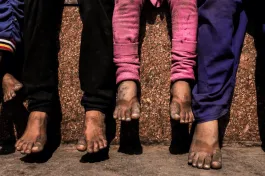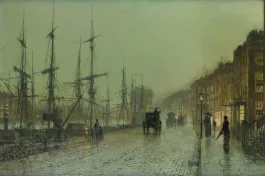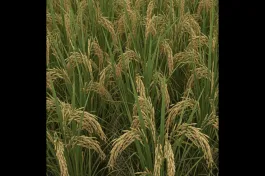Kesava Menon claims he’s just a journalist, sent to Islamabad on assignment 1990-1993 by The Hindu as its first Pakistan correspondent. Don’t take that self-deprecation too seriously – he’s a cut or two above the smart reporter. A lucid writer and raconteur, he is a chronicler of his times. In his 2023 book, Never Tell Them We Are the Same People he shares more ethnological wisdom than you’d get from reading a bunch of boring social science PhD theses.
I do not recall having met him in Islamabad although I had been living (and still live) there some 20-plus years before his posting. To meet wouldn’t have been easy anyway because for a Pakistani university professor like me to meet with any Indian would have had the ISI breathing down my neck.
Reading through Menon’s book, my feelings fluctuated. I endorse his position that the Pakistani military – which has controlled the country either upfront or from the shadows – has engineered an anti-India mindset amongst my countryfolk and helped to create a “collective neurosis.” Indeed, how else could this institution have served itself the delicious privileges it enjoys? But we must not be unfair: elites everywhere, political and military, play the time worn game of stirring animosities against another country for immediate gains. These days you need only look to see how Putin & co have succeeded in demonising Ukrainians. Or, for that matter, the unflattering images the India’s political elite have created about neighbouring countries, not just Pakistan.
Mixed feelings
Menon’s is a work replete with examples of his personal encounters that could be leveraged both ways. They are informative and perceptive, but his conclusions can sometimes be dubious.
In the very first chapter the author stridently claims that Indians don’t really fear Pakistan (and presumably its nukes as well). Instead, a “far, far greater proportion of us [Indians] look at Pakistan with loathing and contempt, an imbalance that exposes the futility of a policy of terror.” Ergo, we are not the same people. So, notwithstanding occasional bonhomie, and how Pakistanis and Indians naturally gravitate towards other when they are in the West, he hints that deep down we are different and so can never truly be friends. Ah, but doesn’t that smack of the 'Two Nation Theory'?
We must not be unfair: elites everywhere, political and military, play the time worn game of stirring animosities against another country for immediate gains.
Before we rush to such a stark conclusion, perhaps we need to consider other people’s experiences as well. An example from earlier this month: a maverick Pakistani motor-cyclist Abrar Hassan took a 30-day 7000 km trip around India on his BMW adventure bike. His uploaded YouTube videos show welcoming locals riding along with their motorbikes soon after he crosses the Wagah border. Given the near-impossibility of a Pakistani getting an Indian visa (we’re all supposed to be terrorists, remember?) this shows that the move to demonise hasn’t worked all that well.
To me, my own experience is far more persuasive. The love and affection I received in 2005 during my four-week-long lecture tour of seven Indian cities – Delhi, Mumbai, Poona, Hyderabad, Bangalore, Chennai, Bhubaneswar – were enormously positive experiences. That was a time when to get an Indian visa wasn’t too difficult. Every day of my visit was filled with lively interactions with school students, college and university teachers, and physics colleagues at the Tata Institute of Fundamental Research, Mumbai, as well as two Indian Institutes of Technology. One 12-year-old in a run-down Delhi school had never seen a Hindi-speaking Pakistani (I was actually speaking Urdu). She came to the front of the class and poked me with her finger to see if I was real, and then hugged me.
There is no denying that, since the late 1980s, the Pakistani military establishment secretly set up jihadist insurgents to wrest Kashmir away from India
The author expertly relates several amusing anecdotes from his days in Pakistan some thirty years ago. I can share my more recent ones from India. On the way to visiting my friend Rajmohan Gandhi in Gandhinagar, my wife and I passed through Ahmedabad. Thanks to a new law, only foreigners could purchase alcohol. Pakistanis, of course, are the most foreign of foreigners! Sadia and I were only too happy to oblige all who asked. We got quite a kick out of the fact that back home possession of alcohol could put us in jail but a green passport in Gujarat had made us wildly popular in Prime Minister Narendra Modi's home state.
Such silly stories tell us a little – but only a little – about another country. There are, of course, far larger issues that stem from an incredibly bloody genesis. There is no denying that, since the late 1980s, the Pakistani military establishment secretly set up jihadist insurgents to wrest Kashmir away from India. I am direct witness to what the author describes as “wild-eyed mullahs exhorting even wilder-eyed and frothier-mouthed hordes to undertake jihad.” This miserably stupid policy eventually boomeranged and put the army itself in their cross hairs, the final straw being the slaughter of over 120 children at the Army Public School in Peshawar in December 2014.
Fortunately, that episode of jihad is now behind us. Thanks to the pressure generated through the the Financial Action Task Force, the global watchdog, militant leaders like Hafiz Saeed and his lot have been banished from the scene. The author decries the “hysterical animosity” of the Pakistani media while correctly noting that the Punjabi establishment – both the military and the landholding class – had imposed their world view on the country as a whole. However, he should have added that Balochistan, Sind, and Gilgit-Baltistan never quite went along with Punjab and the establishment media. Also, although only a few of us spoke out, let it be noted that quite a few Pakistanis had opposed the use of terror as a weapon even during the heydays of jihad.
The other Pakistan
To his credit, Menon admits the existence of another Pakistan. It is one which reveres Bulleh Shah and other Sufi mystic saints, one of Amir Khusro, Ghalib and Faiz Ahmad Faiz, and one which honours Hindu philanthropists for establishing most pre-Partition private hospitals and colleges. This is the Pakistan to which my father belonged. As a Sindhi who was also Muslim, his only friends were Sindhi Hindus. When they had to flee, he was devastated. My elder brother Samir recalls the time when, while my mother was in a sanatorium in Poona, Gandhiji had placed his hand upon the young boy’s head.
What we imbibed at home was not very different from that in many other Sindhi households but it certainly wasn’t the mainstream. In my Karachi school of the 1960s, Gandhi was depicted as a devious figure and Nehru an arch politician. Amazingly, with some twists, this is how many of today’s India’s right-wingers portray the Gandhi-Nehru duo. As the Pakistani narrative goes, Gandhi tricked Muslims into believing he was on their side when in fact he wasn’t. It was he who introduced religion into politics, not Jinnah. But it was never explained to us that Gandhi’s support of the Khilafat Movement was intended to join Muslim to Hindu for battling the British together.
For all my admiration of Kesava Menon’s skills in telling stories, I fundamentally disagree with his use of excessively broad brushes to separate “us” Indians from “them” Pakistanis. This critical matter should be approached carefully and here’s where we need to listen to a bit of theory from sociologists and anthropologists.
Everywhere people identify with a nation, their 'own nation'. But, as Benedict Anderson argues in his book Imagined Communities, every nation is an imaginary entity. While you cannot know personally more than a few hundred people of your 'own kind', yet you believe that you belong to that kind. This suggests that all communities larger than primordial villages are mere figments of the imagination. Until a century and a half ago, these identities were amorphous. If we go back far enough, there were no nations – not even two. The nation state was imagined just yesterday.
For all my admiration of Kesava Menon’s skills in telling stories, I fundamentally disagree with his use of excessively broad brushes to separate “us” Indians from “them” Pakistanis.
Lest I be misunderstood, let me underscore this point. Today’s nation-states are indeed very real and physical. India and Pakistan bristle with nuclear weapons that serve to remind us of this grim reality. But a nation – or your 'own' – is something non-material, an abstraction that exists only in your mind and nowhere else. You cannot ever discover an abstraction, you must invent it! This is just like in pure mathematics – ordinary numbers or perfectly straight lines or non-commuting numbers don’t exist anywhere. Your mind is what gives them life. The corollary is: we keep inventing abstract new divides while old ones quietly fade into obscurity.
The same people?
As I have just argued, all communities are imagined. So, are we Pakistanis and Indians the same people? Well, yes and no. Both answers are important to understand.
First: yes, we are the same! It’s a no-brainer that a lot of Indians and Pakistanis look alike, enjoy the same genres of music and drama, are cricket crazy, and have the same mental makeup. Everyone loves Lata Mangeshkar. Despite China and Pakistan being strategic allies, and notwithstanding various inducements to intermingle (such as the massive Pak-China Centre in Islamabad), one does not see significant Chinese-Pakistani bonding. Pakistani students studying in China, or Chinese workers in Pakistan, find it difficult to overcome the ethnic and linguistic divide.
Yes, we are the same. It’s a no-brainer that a lot of Indians and Pakistanis look alike, enjoy the same genres of music and drama, are cricket crazy, and have the same mental makeup.
The similarity of Pakistanis and Indians comes out even more powerfully when one thinks of Partition era killer gangs – Muslim, Hindu, Sikh – that wantonly stole, raped and murdered the 'other'. That’s when the 'lungi' test was applied: men were forced to disrobe and their state of circumcision revealed. Women were problematic, and sometimes the wrong ones got raped and killed. Everything could have been so much simpler if facial features, height, and build had been sufficient to tell the difference. But they were not and so sometimes people mistakenly killed or raped their co-religionists. Even if a DNA kit had existed in those times, it could not have told the ‘difference’ between Hindu and Muslim.
The Indian liberal and the Pakistani liberal share multiple common values. I would dispute Menon’s assertion that “Pakistani desire for a liberalised social atmosphere is quite distinct from their feelings about India and the attainment of one need not lead to a change in the other.” That, in my observation, is plain wrong. Lifestyle liberals in Pakistan are more likely to be friendly towards India than the bearded types. Knowing some rather discerning Indians, I also think Menon’s characterisation of Indian visitors impressed by Pakistani hospitality as “parachutists” is unfair.
But, yes, we are also different. Pakistan and India are travelling on different, divergent paths with the relative distance increasing with time. This has created two different, distinct environments that have definite cultural, behavioural and economic consequences. Examples from evolutionary biology tell you that the consequences of environmental change are plentiful. Humans and human societies, like animals and birds, are malleable.
Let me first remind the reader of Darwin’s finches. The HMS Beagle’s voyage of 1831 touched the pristine Galapagos Islands where the young and curious Charles Darwin came across birds that were similar yet different. All were short beaked on one island and long beaked on another. Why so, asked Darwin, given that the first birds were almost certainly identical. The answer lay in the environment: a short beak sufficed for digging out insects from loose soil on one island, while the hard soil on another island required a tougher, longer beak.
Yes, we are also different. Pakistan and India are travelling on different, divergent paths with the relative distance increasing with time. This has created two different, distinct environments.
The Pakistani and Indian economies – and hence their cultures and peoples – are diverging. Their achievement levels in industrial production, space exploration, computers or pharmaceuticals are different. India has far outpaced Pakistan. But the longer beaks have come not from the soil but, instead, are consequences of different political environments. Easy money from America during the Cold War allowed bad practices in governance in Pakistan – particularly those in education – to go unpunished. Without meritocracies, academia and industry floundered and collapsed.
Pakistan’s self-seeking civil and military elite has much to do with the rot. Largely Punjabi, it holds a flawed concept of Pakistani nationalism directed against India. Having been in the saddle for decades, it had hoped to continue indefinitely by surfing the waves generated by the US-USSR confrontation. But that hope started to vanish when the US pulled out of the area after the collapse of Kabul in 2021. Today, although the Pakistani establishment had assumed otherwise, it has been taken aback by China’s rude refusal to step into America’s shoes. Pakistan’s present crisis is finally forcing it to recalibrate. How soon it can do so – and how far it will go – is unclear.
For all that, the two countries are not so different when it comes to human wellbeing. Pakistan's Human Development Index (HDI) stands at 161 out of 192 countries. But India, notwithstanding its technological prowess, is no model with an HDI index rank of 132. Its neighbours Bhutan (127) and Bangladesh (129) do better.
Referring to his Islamabad experiences, Menon perceptively asks how long a people can maintain high levels of hostility without damaging their collective mental health. He then answers it by saying that a negative outlook towards others inevitably extracts a price from those holding such views. Such negativity, he says, surely must retard a society’s growth as much as it does that of an individual. He is spot on.
Indeed, defining one community in permanent opposition to another is bad for collective mental health.
He further remarks that “it is fascinating to watch when the consciousness gets expanded by wider experience”, referring here to his observation that some Pakistanis have managed to penetrate the ideological straitjackets they were forced into. That’s a good cheery thought – sheer common sense does often manage to win, especially if the conditions are right.
On a positive note
To end on a relatively happy note, Pakistan, beset by the severest existential crisis after Bangladesh, has considerably toned down its rhetoric and improved its behaviour. This should be seen as an opportunity and used appropriately for a more peaceful South Asia. Unfortunately, in India, where the pot of aggressive nationalism is merrily boiling away, and secular forces have weakened, this tends to be dismissed as a sign of Pakistan having been brought to its knees.
Menon cautiously observes that “we Indians too are currently caught up in a struggle to define ourselves” but hopes that ultra-nationalists “will learn from Pakistan’s experience that the adoption of such a worldview will only lead to collective neurosis.”
Indeed, defining one community in permanent opposition to another is bad for collective mental health. If there is one lesson to be learned, it is that India must not follow Pakistan. As the disasters of 1947 and 1971 conclusively proved, to divide peoples is far easier than to unite them.
Pervez Hoodbhoy is a nuclear physicist who taught at Quaid-e-Azam University, Islamabad, for nearly 50 years. He is the author of Pakistan: Origins, Identity and Future (Routledge, 2023).









